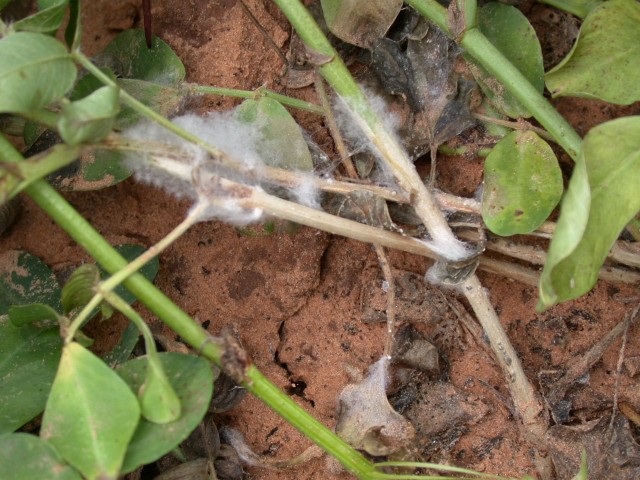
White Rot
Sclerotinia Sp.
Pathogen:
Fungus
Type:
Risk:
HIGH
Moho blanco
Plantas decorativas de jardín y/o interior


WHO CAUSES IT?
Sclerotinia sp. It is a pathogenic fungus that affects a wide variety of plants. This fungus develops in the soil and produces sclerotia, resistance structures that can survive in the soil for several years under adverse conditions. Sclerotia germinate in the presence of favorable environmental conditions, such as high humidity and moderate temperatures, producing apothecia, which are small cup-shaped structures. The apothecia release spores called ascospores, which are dispersed by wind and water, infecting the plant tissues of the host plants. The infection generally begins in the lower parts of the plant, where the spores encounter high humidity conditions, and spreads rapidly causing decomposition of the affected tissues.
SYMPTOMS
White rot caused by Sclerotinia sp. significantly affects plants, causing symptoms that can lead to a considerable loss of vigor and production.
- Appearance of watery Taches on stems and leaves.
- Decomposition of the affected tissues.
- Formation of a white cottony mass in diseased tissues.
- Withering and collapse of the aerial parts of the plant.
- Presence of black sclerotia inside the stems and roots.
- Delay in the growth and development of the plant.
- Premature fall of flowers and fruits.
- Death of young plants and weakening of adult plants.


TEMPERATURE AND HUMIDITY
15°C a 25°C
70% a 90%
TRANSMISSION ROUTES
Spores carried by wind, Contact with infected soil, Contaminated tools, Irrigation with infected water, Infected plant material, Movement of sclerotia in soil
Do you want to remove this pest? Choose how you want to treat it.
TREATMENTS
Chemical treatments
• AZOXISTROBIN 25% [SC] P/V
• CIPRODINIL 37.5% + FLUDIOXONIL 25% [WG] P/P
• PHENHEXAMIDE 50% [SC] P/V
• PIRACLOSTROBIN 6.7% + BOSCALIDE 26.7% ( ) [WG] P/P
• PIRACLOSTROBIN 6.7% + BOSCALIDE 26.7% (I) [WG] P/P
Authorized treatments in organic farming
-
Biological control
• BACILLUS AMYLOLIQUEFACIENS subsp. plantarum (strain D747) 5% [SC] P/V
• BACILLUS SUBTILIS (STRAIN QST 713) 1.34% [SC] P/V
• PYTHIUM OLIGANDRUM (strain M1) 17.5% [WP] P/P
• TRICHODERMA ASPERELLUM (STRAIN ICC012) 2% + TRICHODERMA GAMSII (STRAIN ICC080) 2% (3 X 10E7 CFU/G (SUM OF BOTH MICROORGANISMS)) [WP] P/P
• TRICHODERMA ASPERELLUM (STRAIN T25) (1X10E8 CFU/G) 0.5% + TRICHODERMA ATROVIRIDE (STRAIN T11) (1X10E8 CFU/G) 0.5% [WG] P/P
• TRICHODERMA ASPERELLUM (STRAIN T34) 12% (1.0 x 10E12 cfu/kg) [WP] P/P
• TRICHODERMA ATROVIRIDE (STRAIN I-1237) (1x10E8 cfu/g) 5% [WP] P/P
Recommendations
- Carry out crop rotations with non-susceptible species to reduce the accumulation of sclerotia in the soil.
- Use specific fungicides in seed treatment and during the crop cycle.
- Implement agricultural management practices that reduce moisture in the soil and foliage, such as drip irrigation.
- Remove and destroy the remains of infected crops to prevent the spread of sclerotia.
- Use resistant cultivars when available.
- Maintain an adequate planting density to improve air circulation and reduce humidity.
- Apply organic amendments to the soil that promote the activity of antagonistic microorganisms.
- Constantly monitor crops for early detection of symptoms and apply control measures in a timely manner.
- Avoid excess nitrogen fertilization that favors the development of tender and susceptible tissues.
Sponsored link
Sponsored link
Sponsored link
Sponsored link
Sponsored link
Sponsored link
Effective against all types of fungi
TREATMENTS
Homemade remedies
There are no home treatments
Natural allies
Chemical treatments
There are no treatments for this disease. Treatments are directed at the insect vectors that transmit it. See insect treatments.
RECOMMENDATIONS
- Check the back of the leaves frequently, especially in dry weather.
- Spray water on the leaves to increase humidity and prevent them from settling.
- Keep plants healthy with good watering and adequate light.
- If you see cobwebs or damage, clean the leaves with a damp cloth or pressurized water.
- Use potassium soap or neem oil every few days until they disappear.
REPELLENT PLANTS
Rosemary, Dill, Coriander
EFFECTIVE PRODUCTS TO ELIMINATE THIS PEST
Sponsored link
Sponsored link
Sponsored link
Sponsored link
Sponsored link
Sponsored link
Effective against all types of fungi
*The recommended treatments are recommendations based on the authorities' databases and do not replace in any way the guidelines established by the legislation of each country.
*Products shown are recommendations and not our own products. As Amazon Associates, we earn revenue from purchases of recommended products.






















